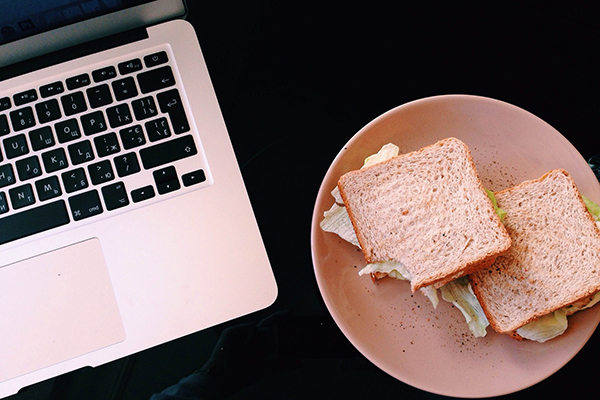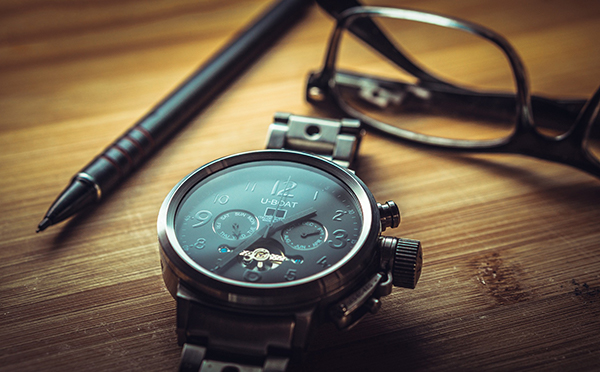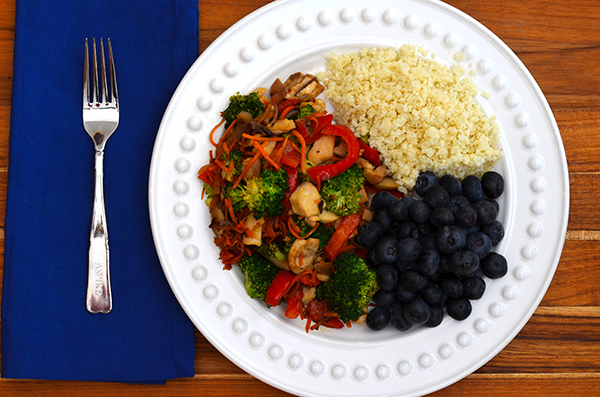If you sometimes sneak in a quick dinner while driving your kids to practice or a hold a sandwich in your left hand while typing the last few lines of your project with your right, then you are no stranger to distracted eating. Or maybe the big surprise ending to your TV show is that only a few crumbs are left in the party size bag of potato chips in your lap. When you engage in other activities as you eat, you increase your chance of weight gain, heartburn, indigestion, and poor absorption of nutrients from your food.
Always on the go? Being stressed may result in overeating or undereating. In addition, your sympathetic nervous system gets over-activated (think fight or flight mode) in times of stress. Under physical or mental stress, blood flow is diverted away from the digestive system, so the breakdown and movement of food through the GI tract is affected, often causing GI symptoms.
When you relax as you eat, your nervous system shifts its focus to resting and digesting (parasympathetic response). It is during this state that all of your digestive functions are able to be fully engaged. Read more about how stress versus mindfulness affects digestion here.
Do you eat while distracted? These tips can help you make the most of your meals. #saslife Click To TweetAsk yourself the following questions to start eating more mindfully:
1. Am I truly hungry? When do I eat
For many of us, we are used to eating either when the clock tells us it’s time to eat or as a knee-jerk reaction to some emotions we are feeling. Eating in this way deconditions us from recognizing actual physical hunger. Check in with your hunger level before your next bite. Don’t be discouraged if it is difficult to determine your true level at first. With time, you’ll get more sensitive to your own physical hunger cues.
2. Why am I choosing this food? What do I eat
This is more about the specific foods that you choose. If you’ve already established that you are hungry, then think about the food you’ll eat. If it is both nutritionally balanced and delicious, then it is likely a good choice.
If the food is either delicious or nutritious, then you may want to look at bit closer at your return on investment. If it is nutritious, but not delicious, can you add some seasonings or a healthy topping to make it tastier? If it is delicious with little nutritional value, it may still be worth eating if you are able to control your portion size.
If the food is neither nutritious nor delicious, but you're on a time crunch and it will fill you up, it might be worth investigating these convenience options and semi-short cuts so you have a better plan next time.
3. Am I paying attention to my food? How do I eat
Set the stage for a satisfying dish by sitting at a table to eat. Turn off all of your devices. If you tend to eat while scanning social media, reading a book or working, try to focus just on your meal for a little while. As you prepare to eat, take a few slow, full breaths to help shift your body into “rest and digest” mode. Notice the colors, shapes and aroma. As you take each bite, pay attention to the flavor and texture. Chew your food thoroughly, and remember to swallow your first bite before you take the next. Between bites, put your food or fork down and breathe. If you are with others, pause to talk to them between bites.
Once you have eaten about half of your food, there’s one more bonus question to ask:
4. Am I still hungry or am I satisfied? How much do I eat
Observe any clues that indicate you are starting to feel satisfied, and check in again with your hunger level. You may notice as you start to get full, the food doesn’t taste quite as good as it did at the beginning of the meal. Out of habit, we often clean our plates, but checking in frequently with your hunger level will help to guide you to eating just the right amount.
TO LEARN MORE, CHECK OUT THE SEMINAR MATERIALS FROM MINDFUL MEALTIME: YOUR PRESENCE IS REQUIRED.
Roasted Mango with Coconut
Recipe Adapted from EatingWell.com
Makes 4 Servings
Ingredients
2 medium ripe mangoes, peeled and cubed
4 tablespoons flaked unsweetened coconut
1 teaspoon orange zest and juice from ¼ orange
1 tablespoon finely chopped crystallized ginger
1-2 squares 85% dark chocolate (optional)
Directions
- Preheat oven to 350°F. Place mango cubes in four 6-ounce custard cups.
- Combine orange zest and juice, coconut and crystallized ginger in a small bowl. Then sprinkle topping over mango cubes.
- Bake about 10 minutes or just until topping begins to brown.
- Use a vegetable peeler to top each dessert with flakes of dark chocolate (optional).






